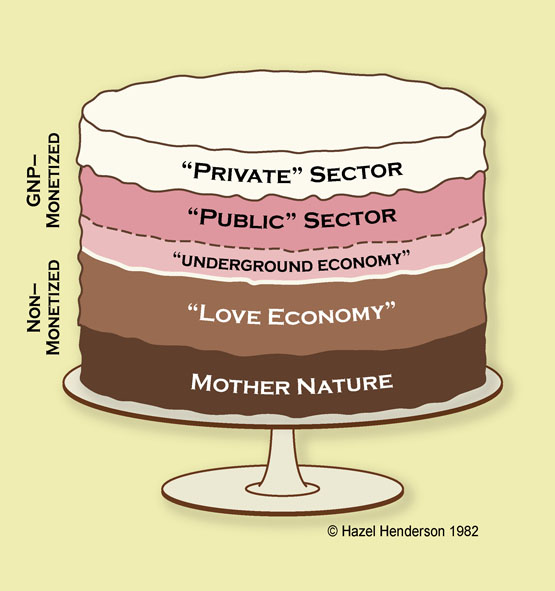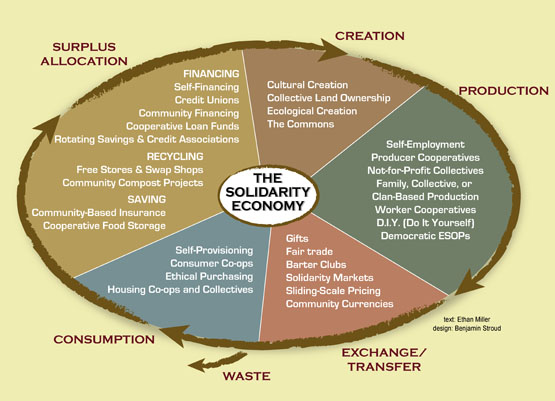ResourcesThere are many resources that can be used in the Community Partnering process to generate discussion, excite interest and mobilize action. We include here just a few:
Representations of EconomyMany non-mainstream thinkers have attempted to represent a more holistic view of economy. Some of these images are included here. Each representation highlights a different set of issues about what is included and excluded from mainstream representations of the economy. These images can be used to provoke discussion about what makes up an economy. The Economy Represented as a Layer Cake This image was produced by the feminist economist Hazel Henderson.
The Economy Represented as Pies and Pieces These two pie images show the US economy divided into sectors of relative size. The first, compiled by Sam Bolwes and Rick Edwards, shows that the monetized commodity sector is only half of all economic transactions that make up the US economy. The other transactions take place in the household and the government sectors.
The second pie is an invention of J.K. Gibson-Graham. It divides the commodity sector up to distinguish between goods and services produced within capitalist firms, those produced by independent or sole proprietors, those produced by cooperatives and those produced by slave enterprises (for example in the US prison system). These divisions are based on guestimates as there are no statistics collected on the output of these other important sectors. This representation shows that the capitalist commodity sector is but a small portion of the total economy. The Solidarity Economy This representation of the solidarity economy has been conceptualized by Ethan Miller. It includes elements of the diverse economy into an image that captures the flow of processes within an economy. It shows the diversity of practices of Creation--Production--Exchange/Transfer--Consumption and Waste--Surplus Allocation
Case Studies of Diverse Economic Practices in Asia
Diverse Economies in SE Asia Case Studies 2003 Websites of Interesthttp://www.pluggingtheleaks.org/ The New Economics Foundation has a Plugging the Leaks website that introduces strategies for local communities to retain the value created within them. http://www.communityeconomies.org/ The Community Economies Collective is a group of scholars around the world who are theorizing and building ethcial economies in place. This webiste contains academic papers, community resources, reports on action research projects and other website links of relevance to diverse economies. Further ReadingJenny Cameron, J.K. Gibson-Graham and Stephen Healy, 2011 Take Back the Economy, Any Time, Any Place University of Minnesota Press, USA (forthcoming). J.K. Gibson-Graham, 2006 A Postcapitalist Politics University of Minnesota Press, USA. Alison Mathie and Gordon Cunningham, Editors 2008 From Clients to Citizens: Communities Chaning the Course of Their Own Development Practical Action Publishing, UK. John Pearce, 1993 At the Heart of the Community Economy: Community Enterprise in a Changing World London: Calouste Gulbenkian Foundation John Pearce, 2003 Social Enterprise in Anytown London: Calouste Gulbenkian Foundation |


